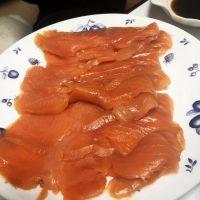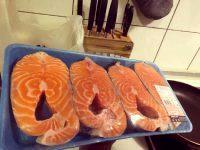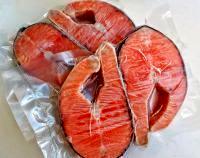How To Choose A Salmon?
New Year’s holidays are ahead, which means that buying delicacies is the right time. How to choose a delicious red caviar (not fake), we have already written in this article. It was the turn of the salmon, because what kind of feast without snacks with salmon ?! Let’s try to figure out which red fish to buy and which side to go around.
Which fish is dangerous to buy
The idea to write this material would not have arisen if all the seafood on the market and in the stores were equally good, but the trouble is that there is almost no quality product on the shelves. Most of the fish is grown artificially in violation of the norms and rules of its content – it is fed with growth stimulants (like broiler chickens or young bulls). Such meat by its nature can not be considered useful.
Using a chemical-inflated product can be dangerous to your health. The risk of food poisoning, allergic reactions, disorders of the gastrointestinal tract increases. Therefore, it is worth being very careful when buying fish. What to look for first?
Signs of fake salmon
The most important thing the buyer should know: the name “red” has a very mediocre relation to the color of the meat. Therefore, the statement, the brighter the shade, the better the fish, a fundamentally wrong and completely pale-looking fish may turn out to be much better, tasty and useful.
Almost all the fish that is sold in stores is painted, experts say. And the reason for this deception is ourselves. The manufacturer simply follows the consumer’s lead and makes the fish “more beautiful”, redder. Such a product is better bought (misconception about the color works great). Bright products attract more attention.

Fresh Salmon
How to distinguish painted fish from the real one?
Make it easy. Carefully consider the fillets, if possible (meat without packaging or it is transparent). Fillet of natural red fish has a heterogeneous pinkish color and white veins. In colored fillets of a more poisonous color and always without streaks (the dye provides the product with a uniform color).
There is another way. True, you still have to buy the product. To do this, make a sandwich with butter, and put slices of salmon on top and leave for some time. If after 10 – 15 minutes the oil is colored, the fish is colored. This product is better not to eat, and throw out without residue.
As a rule, they color fish fillets that have already spoiled, have been repeatedly frozen and so on. In other words, the quality of meat has deteriorated. Then dye comes to the rescue. The fish is washed and treated with a special solution. Food dyes are relatively safe, but only at first glance. Most of them are capable of provoking the strongest allergic reactions, blurred vision, discoloration of the skin. All about the dangers of food additives (not just dyes), read these articles.

Salmon
How to determine that fish were grown artificially
There is a sure sign that the fish were grown in the nursery – it has no fins. They are either not at all, or they are disproportionately small relative to the carcass. This is a consequence and a sign that the fish lived practically without movement (it was fed with growth stimulants and was not allowed to swim). In such conditions, salmon gain weight per pound per week. Artificially grown fish is dangerous to health. Stimulants affect hormones, disrupt the liver, kidneys and gastrointestinal organs.
Let’s sum up the intermediate result. If the fish has small fins and bright red or scarlet meat, it was fed with dyes and growth stimulants (or later tinted with fillets). The best salmon that grew on natural food and in natural conditions, is pale and has long fins.

Salmon Steak
How should look like real meat of a salmon?
This applies to fish, which lies on the shelves, in the thick of snow. It can be approached, examined, gently touched.
If the product is in a vacuum bag, carefully read the ingredients and try to examine the meat through the packaging. It is also important to pay attention to the color and the presence of white streaks. The best pieces are those that are cut closer to the head, but the tail part is usually the least tasty. The tail section can be determined by the characteristic form, as well as by the number of veins (there are more of them in this part).
Sliced fish is better not to buy. As a rule, there goes the most poor-quality fish or even trimming. In the composition of this product more preservatives – benzoic acid will meet necessarily! It is better to buy a piece of the whole or pickle the fish yourself.
Now we know which salmon is better, it remains to figure out where to buy it.
Where better to buy a salmon?
Try to buy fish in proven places. Find an honest seller in the market, or adapt yourself to stock up in a particular store. Yes, traders often deceive customers, but not those who visit them regularly. Everyone benefits from having loyal customers. But this is not a guarantee.
When buying, do not forget to conduct an external examination (for the reasons that we indicated in the article), and do not hesitate to be interested in the accompanying documentation (certificates, etc.). And, of course, the price. Good goods are never suspiciously cheap.

